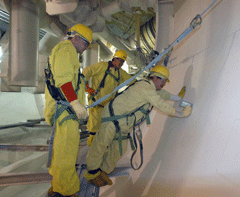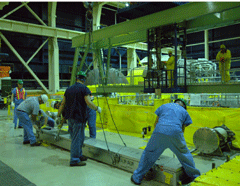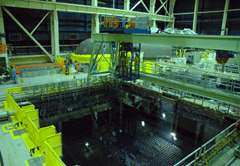New-Old Nukes
Air Date: Week of May 18, 2007

TVA workers measure the thickness of paint on the unit 1 reactor safety system. (Courtesy of Tennessee Valley Authority)
The Browns Ferry nuclear power plant in Alabama has received the green light to start generating power again. The nuclear plant had a near-meltdown in 1975 and was eventually shut down. Host Bruce Gellerman talks with Peter Gwynne who covered the Browns Ferry accident for Newsweek in 1975. He also speaks with Tennessee Valley Authority spokesman Craig Beasley to find out what’s been done to improve safety at the facility today.
Transcript
GELLERMAN: The flame from a candle is supposed to shed light on a subject and in the case of the Browns Ferry Nuclear Power Plant in Alabama it sure did that and a lot more. On March 22, 1975 a single candle nearly burned one of the reactors at Browns Ferry to the ground and exposed just how unsafe the nation’s nuclear power industry was at the time. The plant actually continued operating for another ten years before it was shut down in 1985. But now the ill-fated reactor is once again about to go nuclear and begin generating electricity.
Peter Gwynne was the science editor for Newsweek back in 1975 and wrote about the Browns Ferry reactor fire. Hi Peter- Thanks for joining us.
GWYNNE: Thank you. Good to be with you.
GELLERMAN: Well take us back to that fateful day March 22, 1975. It literally started with a candle.
GWYNNE: It did and a couple of the technicians were in one of the corridors using a candle to sniff out air leaks which was the normal way of doing things at the time. They found a leak in an area where a lot of cables were going into the control room of the plant and they decided to repair it with polyurethane foam, which was again the standard way of doing things.
GELLERMAN: Yeah, but the foam, it turns out, wasn’t fire proof.
GWYNNE: Well, when they tested two things happened. First they realized that they hadn’t sealed up the leak. And second the leak that was there sucked in the flame and set the polyurethane on fire. And then the fire really took off despite all their efforts to control it.
GELLERMAN: And it was right near the control room.
GWYNNE: It was and smoke filled the control room pretty quickly.
GELLERMAN: But this is sort of like falling down a flight of steps. Everything from then on started going wrong.

Workers receive new fuel for reactor 1. (Courtesy of Tennessee Valley Authority)
GELLERMAN: They had to scramble the reactor. They shut it down using the last backup system they had.
GWYNNE: They shut down the reactor, um, even so it continued to heat up. But finally they did manage to close it down and after seven hours the fire went out.
GELLERMAN: It’s kind of weird, using a candle to inspect a billion dollar nuclear reactor.
GWYNNE: Well, that wasn’t the only weird thing, Bruce. Um, they found later that their technicians had not been trained in safety procedures. Ah, they had not tested the polyurethane foam just to check whether or not it was flammable. And a whole series of safety issues, of safety checks, had simply not been performed by the authorities at Brown’s Ferry.
GELLERMAN: What was the mood of the country back then in 1975 to nuclear power. There were 56 reactors operating.

The fuel storage pool for reactor 1. (Courtesy of Tennessee Valley Authority)
GELLERMAN: Peter, thank you very much.
GWYNNE: Thank you, Bruce.
GELLERMAN: Former Newsweek science editor Peter Gwynne wrote about the accident at unit one of the Browns Ferry Nuclear power plant back in 1975. All three of the reactors at the plant continued to operate for another decade before they were finally taken out of service. Units two and three which weren’t affected by the fire went back on line in the 1990s and now, more than three decades after the near disaster, there are plans to bring unit one back online.
The Tennessee Valley Authority owns the Brown’s Ferry plant. Craig Beasley is a spokesman. Craig, thanks for joining me.
BEASLEY: You’re welcome.
GELLERMAN: So, what have you done to improve safety at reactor one?
BEASLEY: Well we have spent a lot of time over the last 20 years working to make safe and reliable power to the people in the Tennessee Valley. You know, when we brought the units off line in 1985 we did a tremendous amount of work to revamp not only Brown’s Ferry but our nuclear program. And since then the units have come back and operated very well, very safely, very reliably to provide power.
GELLERMAN: You’ve also spent a lot of money. What 1.8 billion dollars to bring this reactor back online?
BEASLEY: That’s correct 1.8 billion dollars but what we’re bringing back is probably the newest old plant in the nation. We’ve done a lot of work to ensure that the hardware that we have at the plant is not only current but that it’s in good condition and that we have the people and the programs and the processes in place that are going to make sure that we operate this unit safely and reliably.
GELLERMAN: Wouldn’t it be cheaper to just build a new one from scratch?

TVA workers measure the thickness of paint on the unit 1 reactor safety system. (Courtesy of Tennessee Valley Authority)
BEASLEY: You know when TVA, faced with the growing power demands in the area about five years ago, we looked not only at new generation but you know purchase power, the cost of other fuels like fossil and gas. And we looked at nuclear power and this was the most, the best business decision that we could make; financially, operationally, and environmentally for the area and for us.
GELLERMAN: Any plans to use ah candle tech to check for air leaks in the future?
BEASLEY: (laughs) You know the history of nuclear power is we have a lot of operating experience behind us now. You know you’re talking something 30 years in the past. We’ve had 30 years of operational experience and the industry itself has proved to be safe and reliable. If you look at Browns Ferry now we certainly have, you know, a reactor that’s been there a long time but we have a lot of digital and state of the art instrumentation in the controls and the way we operate these plants now, maintain these plants now is certainly state of the art.
GELLERMAN: Craig Beasley is a spokesman for the Browns Ferry nuclear power plant in Alabama. Mr. Beasley, thank you very much.
BEASLEY: You’re very welcome.
[MUSIC: Pure “La Vaca” from ‘Momentos Perdidos (Lost Moments)’ (Elefant Records – 2004)
Links
The Nuclear Regulatory Commission gave the final OK to put the Browns Ferry Plant back online.
The Tennessee Valley Authority
Living on Earth wants to hear from you!
Living on Earth
62 Calef Highway, Suite 212
Lee, NH 03861
Telephone: 617-287-4121
E-mail: comments@loe.org
Newsletter [Click here]
Donate to Living on Earth!
Living on Earth is an independent media program and relies entirely on contributions from listeners and institutions supporting public service. Please donate now to preserve an independent environmental voice.
NewsletterLiving on Earth offers a weekly delivery of the show's rundown to your mailbox. Sign up for our newsletter today!
 Sailors For The Sea: Be the change you want to sea.
Sailors For The Sea: Be the change you want to sea.
 The Grantham Foundation for the Protection of the Environment: Committed to protecting and improving the health of the global environment.
The Grantham Foundation for the Protection of the Environment: Committed to protecting and improving the health of the global environment.
 Contribute to Living on Earth and receive, as our gift to you, an archival print of one of Mark Seth Lender's extraordinary wildlife photographs. Follow the link to see Mark's current collection of photographs.
Contribute to Living on Earth and receive, as our gift to you, an archival print of one of Mark Seth Lender's extraordinary wildlife photographs. Follow the link to see Mark's current collection of photographs.
 Buy a signed copy of Mark Seth Lender's book Smeagull the Seagull & support Living on Earth
Buy a signed copy of Mark Seth Lender's book Smeagull the Seagull & support Living on Earth

